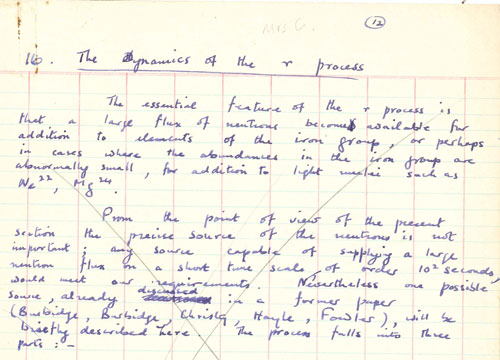Fred Hoyle: An Online Exhibition
Stellar NucleosynthesisThe r-ProcessBy 1949 Hoyle was considering the synthesis of carbon-12. In 1951 Ed Salpeter of the California Institute of Technology (Caltech) hit upon a way of making carbon-12 from helium and beryllium. But it did not produce enough carbon to account for the abundance of this element in the universe. Hoyle realised that, for the reaction to happen efficiently, the resulting carbon nucleus would have to have a particular energy level, a level that carbon was not at that time known to have. Hoyle went to Willy Fowler at the Kellogg Radiation Laboratory at Caltech and asked him to help in the search for this unknown state of carbon-12. Fowler was initially reluctant to assist the pushy Englishman with a strange accent, but quickly realised the consequences for element synthesis in stars if Hoyle’s theory proved to be correct. During a lengthy experiment, the Caltech physicists created excited carbon-12 and found that this higher state was exactly as Hoyle had predicted it. The r-process was one of the several processes incorporated into the landmark 1957 paper 'Synthesis of the elements in stars'. Hoyle's Notebook | The r-Process | B-squared-F-H |  |
|
Home | Contents | Overview | 10 Objects | More Information | Contact |